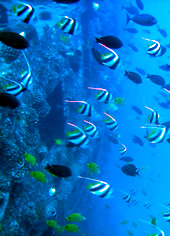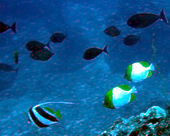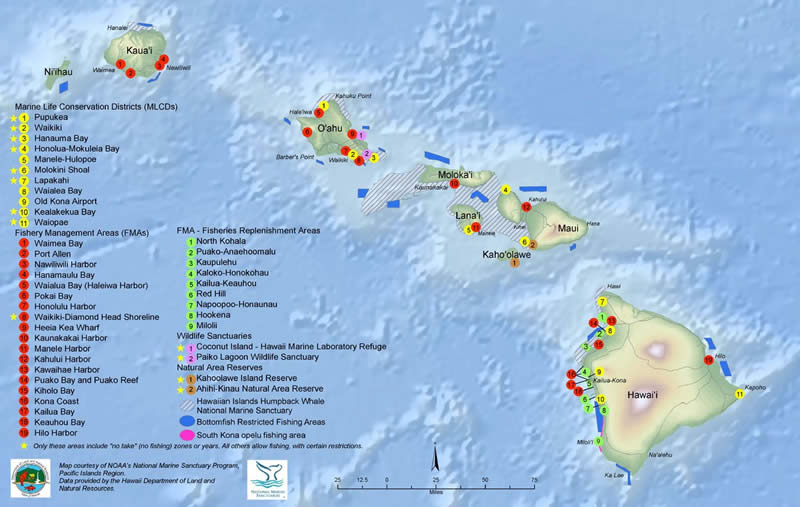A Sustainable Fishery
Hawaii’s aquarium fish are a valuable natural resource. According to the Hawaii Department of Land and Natural Resources, the aquarium fishery is currently the most commercially important near-shore fishery in the state, generating more income than akule, lobster, or even bottom. As fishermen, we depend upon the ocean for our livelihood, and work hard every day to conserve our resources for the future.
Although Hawaii provides only a small percentage of the world’s aquarium fish, we are renowned for our sustainable, humane, and environmentally friendly fishing methods. Unlike some parts of the world, Hawaiian fishermen use only fine mesh nets to capture fish. This method does not damage coral, does not leave rubbish in the ocean, and allows us to release any unwanted fish unharmed. Our careful collection, holding and shipping techniques ensure that our fish arrive healthy. Mortality in transit is typically negligible.
Because fish suitable for aquariums are small, abundant and reproduce quickly, the aquarium fishery in Hawaii has proven to be sustainable. Research conducted since 1997 by the DLNR has shown that the most popular aquarium fish have not declined in numbers over the past 10 years. The same studies have shown that our fishery does not harm coral or otherwise affect the health of the reef.
Renewable
Fish: A Highly Renewable Resource
Marine fish are the most renewable natural resource because they are the most efficient breeders on the planet. Many species can spread or lay one million to 5 million eggs at one breeding (“Marine Biology” text, 5th edition by Peter Castro and Michael Huber).
Most of Hawaii’s fish species are broadcast breeders repopulating wide areas and are found throughout the South Pacific. Most fish can reach breeding size in one year and breed once to twice a year. Large overpopulation fish blooms occur all the time – in 2003 a very large population occurred in the Aweoweo: Yellow Tang, Moorish Idols and Potters Angels are just a few which have had recent large blooms. Reports of this bloom were reported in the news and media.
Yellow Tang populations are out of control in MPA’s (Marine Protected Area) of Kailua Kona and counts are up 90% (DLNR testimony at the last hearing Feb. 2008 stated the yellow tang population was up 90% in FRA’s and 70% in non FRA’s) causing the decline of other species due to decline in food supply (see http://cramp.wcc.hawaii.edu/ and the DLNR web site).
A recent article January 2009 in DAR Fishlife by Marine Biologists Jeremy Claisse and Bill Walsh claim a decline in yellow counts in non-FRA, but it is a conflict with other data from DLNR. Fish populations can vary greatly in a very short time. An example of this below.
“Fish Base” website gathers information about fish habitats and recruitment and tries to estimate there vulnerability. Using this data is used to protect fish species.
In fall of 2014 due to an increase in plankton food supply a much greater number of the 5 million fry per spawning fry live to adult stages. There was a “Biblical Increase in Fish Populations” Link video and news on this:
DNLR Counts
DLNR Counts Prove Sustainability
There are renewable resource and non renewable resources. Fish are the most renewable resource on the planet with yellow tangs producing one million fry per breeding with approximately 60% returning to the reef where born (60% information from radio labeled and DNA studies done on other reef fish species).
To establish depletion one determines known reserves and estimated unknown reserves. Replenish rates are well established by DLNR counts. Then a usage or harvest rate along with estimated increases due to population growth (in our case increase in divers and collection) determines the sustainability of the resource.
A lot of data has been taken. DLNR yearly compilation of monthly catch report data shows the sustainability of our industry.
Catch report data at end. Artificial reefs and decline in our catch for economic reasons are another reason why there is an overall increase in reef fish populations.
DLNR marine biologists have used the L50 which determines the breeding size for each species of fish at half the population. By setting legal takes to protect breeders the State ensures a breeding size population.
Click Here To Read: DLNR Senate Bill 1240
Rotating
Rotating Fishing Spots
Fishermen, divers, net layers and others working in the fishing industries have long used the common practice of rotating their fishing spots which research has proved reduces the impact of fishing in one area. By allowing fish time to repopulate an area (recruitment) fish remain in larger numbers.
Rotating has been used by the State in the Diamond Head reserve where only every other year fishing is allowed. Fish are a renewable resource. Fish can live for 15 years or longer and may breed many times a year. Fry and adult breeding stages are important for the perpetuation of the species. Fish may reach adult breeding size within a few months.
Ecosystems can support only a specific population of fish, and fishing, like hunting, can help perpetuate the health of the species. If you reduce the area for fishing, you increase the impact on the unrestricted areas.


